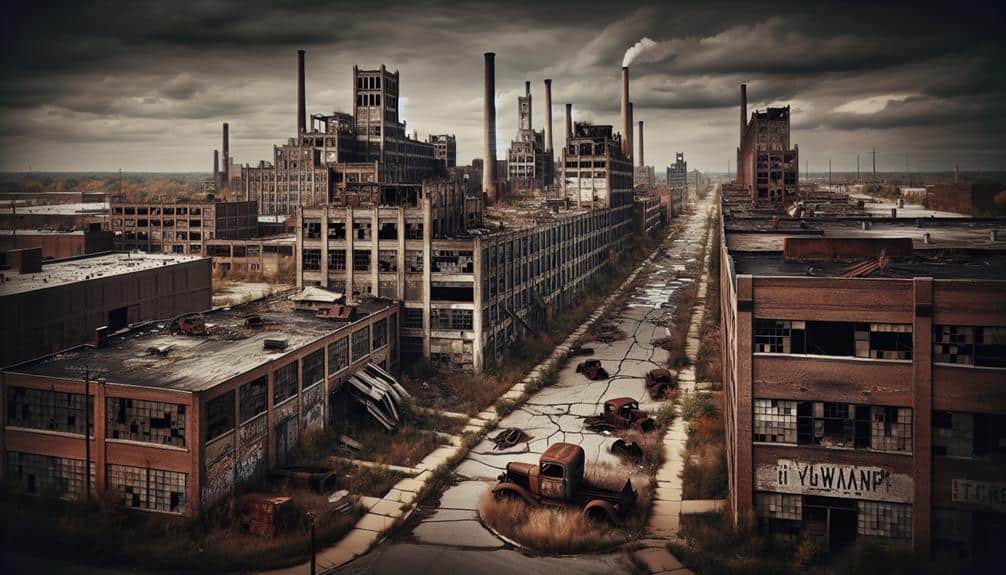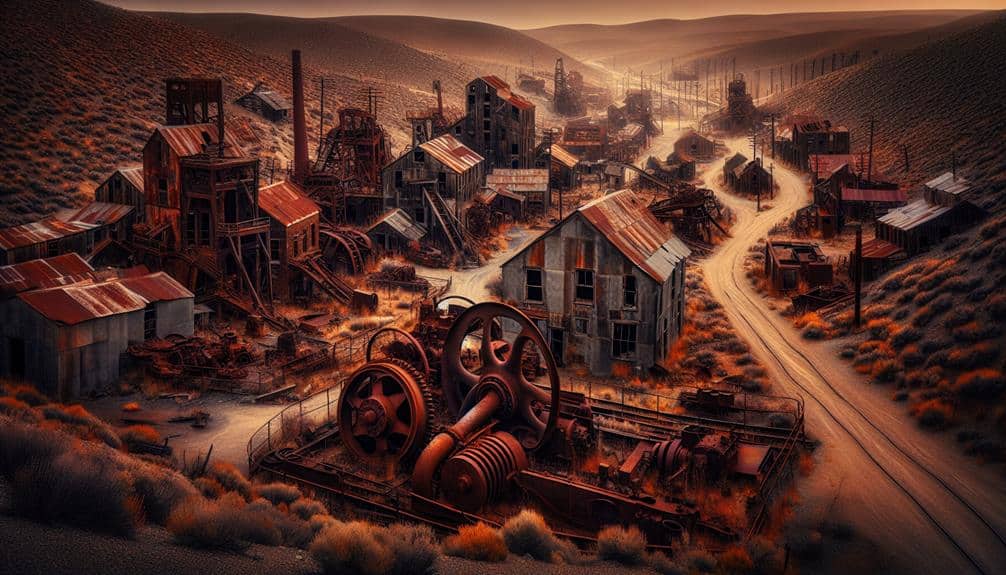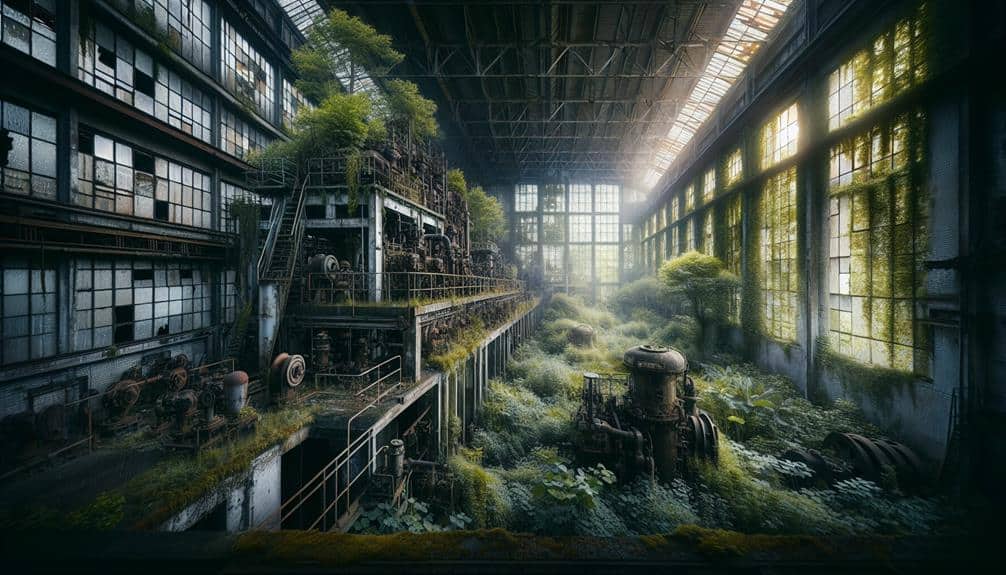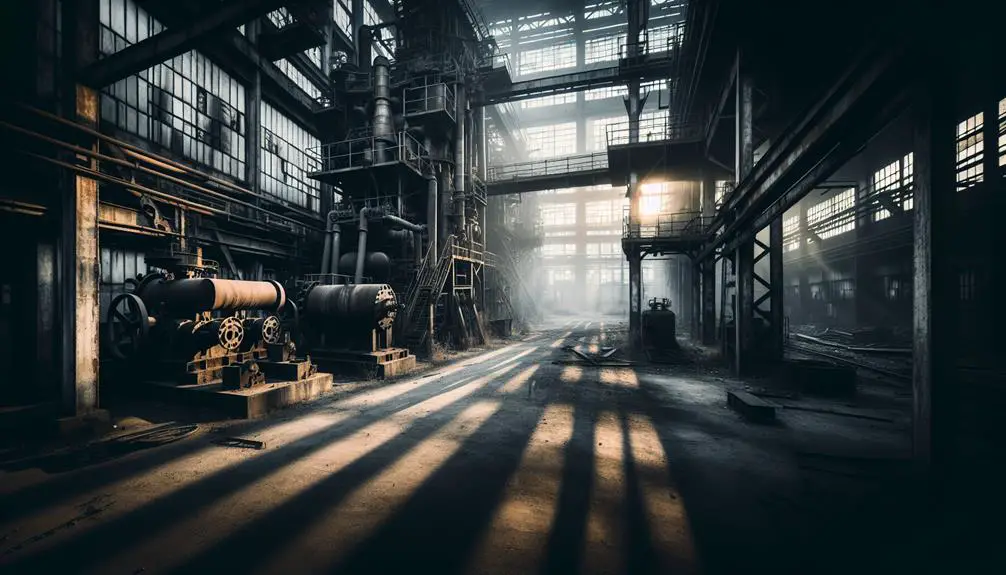Industrial towns in the US turned into ghost towns due to economic changes, tech advancements, environmental harm, and shifting populations. Populations dwindled, industries moved, and jobs vanished. Automation and global markets played roles, displacing workers. Pollution damaged health, and resources dwindled. Younger folks sought opportunities elsewhere, leaving towns empty. To understand fully, consider the impact of these interconnected factors.
Key Points
- Automation and job loss from economic shifts led to population decline.
- Inadequate adaptation to new industries risked towns becoming obsolete.
- Environmental degradation caused health issues, driving people away.
- Urban sprawl and demographic changes influenced migration patterns.
- Limited growth prospects and lack of opportunities prompted residents to seek jobs elsewhere.
Rise of Industrialization in America
During the 19th century, industrialization rapidly transformed the economic landscape of America, leading to profound societal changes. The rise of industrialization brought about a surge in urbanization as people flocked to cities in search of employment opportunities in factories.
However, this shift was accompanied by labor exploitation, where workers, including men, women, and children, toiled in harsh conditions for long hours with minimal pay. The rapid growth of industrial towns also posed significant challenges regarding urbanization, such as inadequate housing, overcrowding, poor sanitation, and lack of basic amenities.
As factories sprang up, industrial towns faced the challenging task of accommodating the influx of workers, leading to the development of cramped and unsanitary living conditions in tenement buildings. The confluence of labor exploitation and urbanization challenges during this period laid the groundwork for the complex social and economic issues that would continue to shape American society in the years to come.
Impact of Economic Shifts
The economic shifts in industrial towns across the US are drastically altering their landscapes and demographics. Job automation and global competition have been significant factors contributing to this transformation.
Job automation, driven by technological advancements, has led to a decline in the demand for manual labor in industries that were once thriving in these towns. As machines become more efficient and cost-effective, companies are increasingly turning to automation, reducing the need for human workers.
Moreover, global competition has intensified, forcing many industrial towns to struggle to keep up with foreign markets offering cheaper labor and resources. This has resulted in the outsourcing of jobs, further impacting the local workforce and economy. As industries move operations overseas to cut costs and increase profits, industrial towns in the US are left grappling with the repercussions.
Technological Advances and Job Loss
Technological advancements have played a pivotal role in the widespread job loss experienced in industrial towns across the US. This shift has been driven by the effects of automation, leading to significant workforce displacement.
- Automation Effects: The implementation of advanced technologies like robotics and artificial intelligence has resulted in the automation of many industrial processes. This has led to a decreased need for manual labor, causing a decline in job opportunities in traditional industries.
- Workforce Displacement: As automation continues to replace human workers in various sectors, employees find themselves displaced and struggling to find alternative employment. This displacement often leads to economic hardship and a sense of uncertainty in industrial towns.
- Economic Transformation: The rapid pace of technological change has forced industrial towns to adapt quickly. Those that fail to shift to new industries or technologies are at a higher risk of becoming ghost towns as job opportunities dwindle, and populations decline.
Technological advances, while beneficial in many ways, have indeed reshaped the employment landscape in industrial towns, highlighting the need for proactive measures to mitigate the impact of job loss.
Environmental Degradation Consequences
The impact of environmental degradation on industrial towns in the US is starkly evident in the significant challenges they face due to pollution and resource depletion. Ecological devastation resulting from industrial activities has led to severe pollution effects on these towns. Air pollution, water contamination, and soil degradation are common consequences of unchecked industrialization. The once vibrant landscapes have been marred by the toxic aftermath of heavy industrial processes.
Pollution effects not only harm the environment but also jeopardize the health and well-being of residents. Respiratory illnesses, waterborne diseases, and other health issues have become prevalent in these areas. The contamination of natural resources further exacerbates the situation, making it difficult for communities to thrive sustainably.
As industrial towns grapple with the aftermath of environmental degradation, the need for remediation and sustainable practices becomes vital. Addressing pollution effects and restoring ecological balance are pivotal steps towards revitalizing these ghost towns into thriving, healthy communities once again.
Migration Patterns and Population Decline
Migration patterns and population decline in industrial towns reflect a stark shift in demographics and economic dynamics, reshaping the social fabric of these once-thriving communities.
- Urban Sprawl: The phenomenon of urban sprawl has played a significant role in the migration patterns of industrial town residents. As cities expand outward, offering new opportunities and amenities, residents often choose to leave the industrial towns behind in search of a more urban lifestyle.
- Demographic Changes: The demographic composition of industrial towns has undergone a notable transformation, contributing to population decline. Younger generations are increasingly moving away in pursuit of higher education and career prospects, leaving behind an aging population with limited prospects for growth.
- Economic Shifts: Changes in the industrial landscape have led to economic shifts that impact migration patterns. As traditional industries decline, job opportunities dwindle, prompting residents to seek employment elsewhere, further exacerbating the population decline in these towns.
Frequently Asked Questions
What Role Did Social Factors, Such as Changing Community Dynamics and Cultural Shifts, Play in the Decline of Industrial Towns in the Us?
When contemplating the decline of industrial towns in the US, changing demographics and community cohesion are vital factors. Cultural shifts and evolving dynamics within communities often contribute immensely to the transformation of these once-thriving areas.
How Did the Decline of Industrial Towns Impact Local Education Systems and Healthcare Infrastructure?
You never imagined how the decline of industrial towns would impact students—limited resources, outdated textbooks. Healthcare access shriveled too, clinics abandoned. Ghost towns reveal the harsh reality: education and health left behind.
Were There Any Efforts Made to Revitalize or Repurpose Abandoned Industrial Sites in These Ghost Towns?
Efforts to revitalize abandoned industrial sites in ghost towns have varied. Economic development initiatives, community engagement projects, urban planning strategies, and historical preservation efforts have been implemented to breathe new life into these areas.
What Were the Long-Term Effects of Environmental Pollution and Contamination on the Health of Residents in These Industrial Towns?
How did environmental pollution affect residents' health in industrial towns? Public policy plays an important role in mitigating long-term effects. Understanding the interplay between environmental health and public policy can guide future decision-making for healthier communities.
How Did the Decline of Industrial Towns Affect Nearby Agricultural Communities and Rural Economies in the Surrounding Areas?
As industrial towns dwindled, nearby agricultural communities faced rural displacement and economic repercussions. Despite challenges, some areas displayed agricultural resilience and community adaptation, seeking new avenues for sustainability amidst the decline of industrial hubs.



